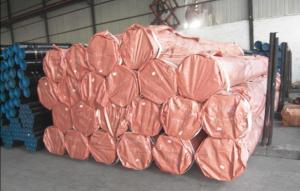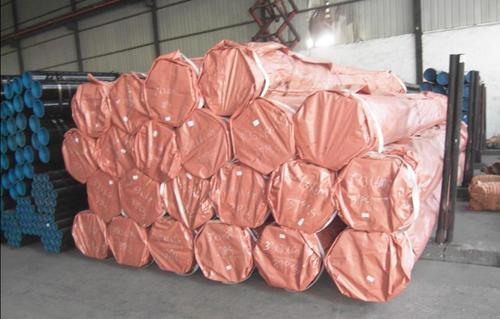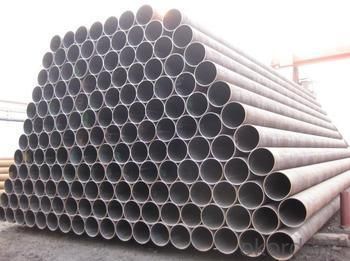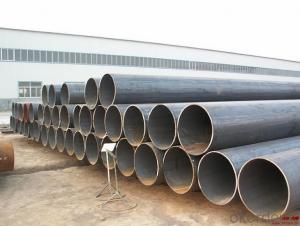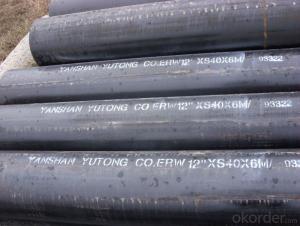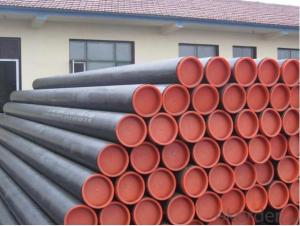ASTM A106 GR.B Seamless Steel Pipe
- Loading Port:
- China Main Port
- Payment Terms:
- TT or LC
- Min Order Qty:
- -
- Supply Capability:
- -
OKorder Service Pledge
OKorder Financial Service
You Might Also Like
1、Structure of Seamless Pipe:
Seamless pipe is made with steel bar by perforating machine. It holds a hollow section and there is no seam around. Resulting from the facture process, seamless pipes are of better pressure resistance than other molds, and was usually more easily available and safe than other pipes. We are factory and definitely will satisfy your demand.
2、Main Features of the Seamless Pipe:
• High working accuracy
• High strength
• Small inertia resistance
• Strong therming dissipine ability
• Good appearance
• Reasonble price
3、Seamless Pipe Specification:
Standard | GB, DIN, ASTM ASTM A106-2006, ASTM A53-2007 |
Grade | 10#-45#, 16Mn 10#, 20#, 45#, 16Mn |
Thickness | 8 - 33 mm |
Section Shape | Round |
Outer Diameter | 133 - 219 mm |
Place of Origin | Shandong, China (Mainland) |
Secondary Or Not | Non-secondary |
Application | Hydraulic Pipe |
Technique | Cold Drawn |
Certification | API |
Surface Treatment | factory state or painted black |
Special Pipe | API Pipe |
Alloy Or Not | Non-alloy |
Length | 5-12M |
Outer Diameter | 21.3-610mm |
Grade | 20#, 45#, Q345, API J55, API K55, API L80, API N80, API P110, A53B |
Standard | ASME, ASTM |
1) Material:20#(ASTM A 106/A53 GRB.API5LGRB,GB),45#,16Mn,10#.
2) Specification range: OD: 21.3-610mm, WT:6-70mm, length:6-12m or according to the requirement of clients.
3) Executive standards: GB, ASME API5L.ASTM A 106/A53,Despite of the above standards, we can also supply seamless steel pipe with standard of DIN, JIS, and so on, and also develop new products according to the requirements of our clients!
4) Surface: black lacquered, varnish coating or galvanized.
5) Ends: Beveled or square cut, plastic capped, painted.
6) Packing: bundles wrapped with strong steel strip, seaworthy packing.
4、Packaging & Delivery
Packaging Details: | seaworthy package, bundles wrapped with strong steel strip |
Delivery Detail: | 15-30days after received 30%TT |
5、FAQ of Seamless Pipe:
①How is the quality of your products?
We test on every pipe before delivery. You can get any quality certification or testing report from us. Our products are strictly in accordance with international standard. If products’ quality don’t accord to discription as we give or the promise before you place order, we promise 100% refund.
②How about the price?
Yes, we are factory and offering you the lowest price in the market. Speed and honesty are our target. No hesitate. if you like bargain and factory price is not low enough as you think, just don’t waste your time.Please trust the quotation we would give you, it is professional one.
③Why should you choose us?
Think of our quality and price. They are charming. SGS test / Customer inspection / Third party inspection is OK. We are factory. So we can make any pipe you need in accordance to your requirement. That's attaracting, right?
6、Seamless Pipe Images:
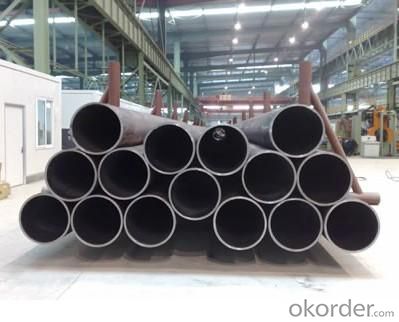
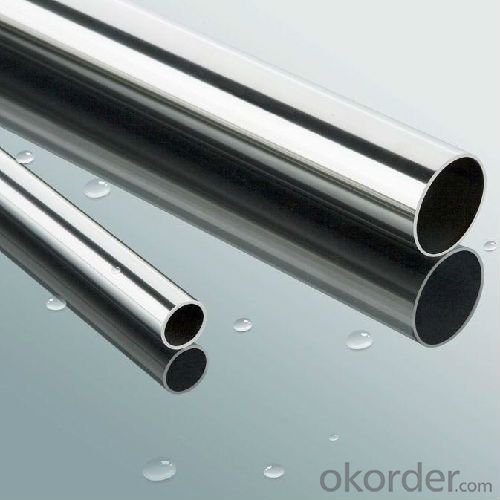
- Q: How to identify stainless steel pipe and steel pipe?
- Stainless steel (Stainless Steel) is referred to as the stainless steel, the resistance of air, steam, water and other weak corrosive medium or with stainless steel known as stainless steel; while the resistance to chemical corrosion (acid, alkali and salt chemical etching) corrosion of steel called acid resistant steel. Because of the difference in the chemical composition of the two, and make their corrosion resistance is different, ordinary stainless steel is generally not resistant to chemical medium corrosion, and acid resistant steel are generally stainless steel.
- Q: How do steel pipes handle chemical exposure?
- Steel pipes are generally known for their excellent resistance to chemical exposure. The high strength and durability of steel make it a reliable material for handling various chemicals. Steel pipes can withstand exposure to a wide range of corrosive substances such as acids, alkalis, solvents, and gases without experiencing significant degradation or damage. One of the main reasons steel pipes handle chemical exposure well is due to their inherent corrosion resistance. Steel is naturally resistant to corrosion and can form a protective oxide layer on its surface, which acts as a barrier against chemical attack. Additionally, steel pipes can be coated or lined with corrosion-resistant materials such as epoxy, polyethylene, or cement to provide extra protection against aggressive chemicals. Moreover, steel pipes are commonly used in industrial applications where they come into contact with different types of chemicals. They are extensively used in chemical plants, refineries, water treatment facilities, and other industries where chemical transportation or storage is required. Steel pipes can handle the high pressures and temperatures associated with these processes while maintaining their structural integrity and chemical resistance. However, it is important to note that the resistance of steel pipes to chemical exposure can vary depending on the specific type and concentration of the chemical. Some highly corrosive substances may require additional measures such as specialized coatings or alloys to ensure long-term protection. In summary, steel pipes are generally well-suited for handling chemical exposure due to their inherent corrosion resistance, durability, and versatility. Their ability to withstand a wide range of corrosive substances makes them a reliable choice for various industrial applications involving chemical transportation and storage.
- Q: How much is the wall thickness standard of building 48?
- Steel tube (Steel pipe) production technology development began in the bicycle manufacturing industry, the rise of the early nineteenth Century during the oil development, the two world war ships, boilers, aircraft manufacturing, manufacturing of power boiler after the Second World War, the development of chemical industry of petroleum and natural gas drilling and transportation, will effectively promote the the yield and quality of varieties, the development of steel tube industry.
- Q: What is the difference between steel pipe and ductile iron pipe?
- Steel pipe and ductile iron pipe are commonly utilized in various industries to transport fluids and gases. Nevertheless, there exist notable distinctions between the two materials. One primary difference lies in their composition. Steel pipe primarily consists of iron and carbon, with additional alloying elements to enhance strength and corrosion resistance. Conversely, ductile iron pipe is a form of cast iron that has undergone treatment to improve ductility and toughness. It contains higher levels of carbon and silicon, along with small amounts of other elements like magnesium and copper. Another difference is their strength and durability. Steel pipe is renowned for its high strength, enabling it to endure greater pressures and stresses compared to ductile iron pipe. It also exhibits superior resistance to impact and bending, making it suitable for applications requiring robustness. Ductile iron pipe, although not as strong as steel, still offers good strength and durability, particularly in scenarios involving external damage or heavy loads. Corrosion resistance is another crucial factor. Steel pipe typically exhibits greater resistance to corrosion due to the inclusion of alloying elements such as chromium and nickel. This renders it well-suited for applications prone to high corrosion risks, like pipelines carrying corrosive fluids. Ductile iron pipe, while possessing some corrosion resistance, may necessitate additional protective coatings to enhance its durability in corrosive environments. Installation and maintenance also differ between these two pipe types. Steel pipe is generally lighter and more manageable, facilitating easier installation. It also allows for welding, thereby providing greater construction flexibility. Ductile iron pipe, being a cast iron material, requires more specialized installation techniques such as mechanical joints or flanges. If mishandled, it is also more prone to cracking during installation. In terms of cost, steel pipe typically incurs higher expenses compared to ductile iron pipe. This stems from the higher cost of raw materials and the additional processing involved in steel pipe production. However, it is crucial to consider the overall lifecycle cost, as steel pipe's increased strength and corrosion resistance may result in lower maintenance and replacement expenses in the long run. In conclusion, while both steel pipe and ductile iron pipe have their respective advantages and applications, the choice between the two depends on factors such as strength requirements, corrosion resistance, installation methods, and budget considerations. Careful assessment of these factors will aid in determining the most suitable pipe material for a specific application.
- Q: How are steel pipes used in the mining and mineral processing industry?
- Steel pipes are widely used in the mining and mineral processing industry for various applications. They are primarily used for the transportation of water, slurry, and other liquids within the mining operations. These pipes are also used for the conveyance of minerals, ores, and waste materials. Additionally, steel pipes are used in the construction of infrastructure such as mine shafts, pipelines, and underground tunnels in the mining industry. They provide durability, strength, and resistance to corrosion, making them a reliable choice for the demanding conditions of mining and mineral processing.
- Q: What is the load-bearing capacity of steel pipes?
- The load-bearing capacity of steel pipes varies depending on factors such as pipe diameter, wall thickness, and the type of steel used. However, steel pipes generally have high load-bearing capacities due to their strength and durability.
- Q: What is the abrasion resistance of steel pipes?
- Steel pipes have a relatively high resistance to abrasion. They possess exceptional strength and durability, rendering them resilient against the detrimental effects of friction and impact. This quality positions steel pipes as a prime option for various industries and applications that frequently encounter abrasion, such as mining, oil and gas, and the transportation of abrasive substances. Furthermore, steel pipes can be fortified with coatings or linings to enhance their resistance against abrasion, tailored to meet the unique demands of each application. In conclusion, steel pipes present a dependable and enduring solution for effectively managing abrasive materials and environments.
- Q: How do you measure the diameter of a steel pipe?
- To measure the diameter of a steel pipe, you can use a caliper or a measuring tape. Place the caliper jaws or measuring tape around the widest part of the pipe, ensuring it is perpendicular to the pipe's axis. Take the reading displayed on the caliper or measure the distance between the two points on the measuring tape. This measurement will provide you with the diameter of the steel pipe.
- Q: How are steel pipes protected against electromagnetic interference?
- Steel pipes can be protected against electromagnetic interference by using various techniques such as applying electromagnetic shielding coatings, implementing grounding measures, using insulating materials, and employing electromagnetic interference filters or suppressors. These methods help to minimize the impact of external electromagnetic fields on the steel pipes, ensuring their integrity and functionality.
- Q: How are steel pipes connected in pipeline construction?
- Steel pipes are connected in pipeline construction through various methods such as welding, threading, and flanging. Welding involves joining the pipes using heat and fusion, creating a strong and durable connection. Threading involves screwing two pipes together using threads on the ends of the pipes. Flanging involves connecting the pipes by bolting together flanges on the ends of each pipe. These connection methods ensure a secure and leak-proof pipeline system.
Send your message to us
ASTM A106 GR.B Seamless Steel Pipe
- Loading Port:
- China Main Port
- Payment Terms:
- TT or LC
- Min Order Qty:
- -
- Supply Capability:
- -
OKorder Service Pledge
OKorder Financial Service
Similar products
Hot products
Hot Searches
Related keywords
